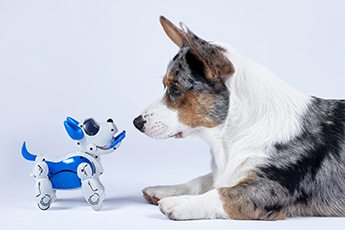Robot Dogs, and Why We May One Day Love Them

By Caroline Coile
What can the programming of robotic dogs teach us about the human-canine bond? It turns out, a lot.
Researchers at the University of Glasgow in Scotland were trying to create a robotic dog that could cause people to bond with it. To do so they needed to find out what it is about our dogs that makes us love them. So, they asked dog owners what it was about their dogs they felt was most important in bonding with them.
But first, what makes you love your dog? The researchers found seven different “themes” or categories of behaviors that seem to be consistent. I tried to think of why I love my dogs (and sometimes, as I am wheeling yet another ruined couch to the dump, or cleaning another floor, or chasing after another dog chasing after a deer, it is very hard to remember!) but I came up with:
- Gives me eye contact. My favorite dogs all give me eye contact.
- Gives me body contact–whether it be a paw on my lap, a nudge with the nose, a full body lean, or a snuggle in bed.
- Plays with me, whether it be fetch or keep-away or tug or soccer or Frisbee, or I’m gonna grab your paws/ouch you’re gonna bite my hands! Or any of the other silly games that fill our days.
- Comes when I call. Okay, at least sometimes. Or at least doesn’t run away. Too far. Sigh. Well, I fantasize that if I had a dog that reliably came when called I would really, really love him.
- Makes me laugh. Like having that goofy friend who never does things the obvious way, I like it when my dogs see how far they can skid on my tile floors even though they could as easily just stop; or they could chase their tail while balancing on the edge of the pool (and fall in), or sleep in some ridiculous pose, or even end up on top of the refrigerator. (Okay, that one’s not always so funny).
- Wag their tail. Who doesn’t like a happy friend? Happiness is contagious.
- Looks pretty. Okay, this is probably a “wrong” answer but it’s true that a dog that fills my eye makes me happy. Or as I say to a couple of my dogs, “It’s a good thing you’re pretty…” (Added in editing: I probably should have said “Is smart.” That would have been a good answer. Oops!)
Now to compare with the actual answers. It turns out I was pretty close (although being pretty was not amongst them).
- Shared activities. These were described as all forms of play, even independent play.
- Proximity. Either within the home, such as following from room to room, or when on a walk and staying close or checking in.
- Communication. This included eye gaze (I got one right!). Also, head tilting in response to listening, or barking at the owner for attention. Nudging for attention also falls in this category, as does placing a toy on the owner’s lap to initiate play.
- Physical touch: This includes licking, cuddling, rubbing, pawing—especially when initiated by the dog rather than the person.
- Consistency: This refers to the dog always being happy to greet the returning owner, or just always being happy, or always coming when called.
- Positivity and enthusiasm: This encompasses excited greeting behaviors–bouncing, wagging tail, smiling expression.
- Attunement: This includes behaviors in which the dog seems to know the owner’s schedule and is waiting for them; for example, in the bed at bed time, or times when the seemed to know the owner was sad and responded by touching or simply being near.
It turns out that these behaviors mirror factors that are important in human interpersonal relationships.
And I think my guesses were pretty close (although as I said they didn’t mention “pretty” as one of theirs). I would have included head tilting had I thought of it, and attunement if that’s the word for the dog seeming to know when I’m sad. And they combined some categories I considered as separate.
Interestingly, a bias the researchers found was that although the study was open to anyone who responded to their social media request, the respondents were overwhelmingly (96%) female, a bias also found in other human-animal bond studies.
The researchers suggest that future robotic animals should prioritize these behaviors that strengthen the canine-human bond. Such robotic pets may one day fill a niche for people such as the elderly who would enjoy the companionship of a dog but cannot care for one. This brings us to another question: no doubt in the future robotic dogs could be made to look and act as real, or almost as real (maybe they won’t pee on the floor or eat your furniture) as our living dogs; they could even be immortal. What if they could even be made to look and act like a former favorite dog of yours? Would you want one? Is there something wrong about making a robot pet so realistic it fools the mind and the emotions into thinking it is real? Is there a Westworld for dogs, and would you want to go there?

Short URL: https://caninechronicle.com/?p=251024
Comments are closed











